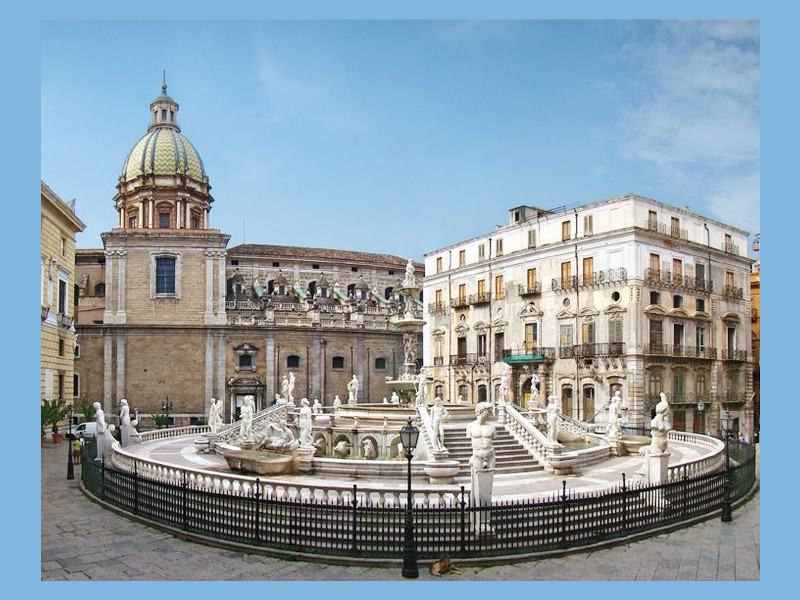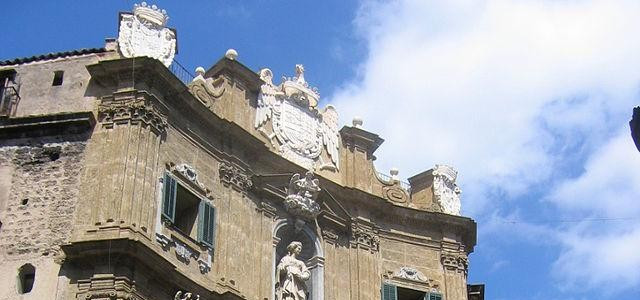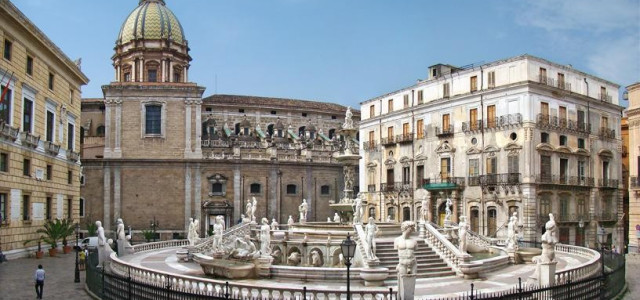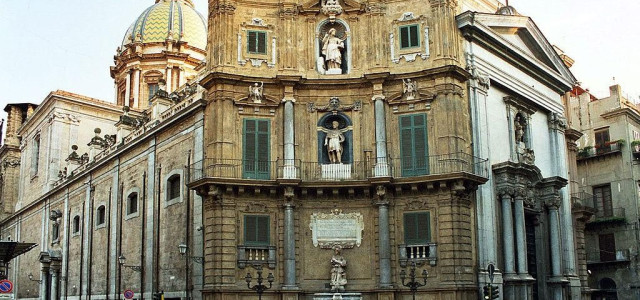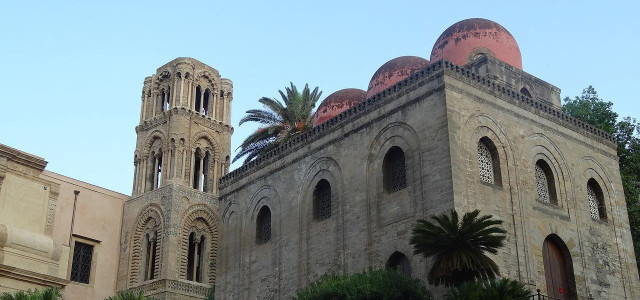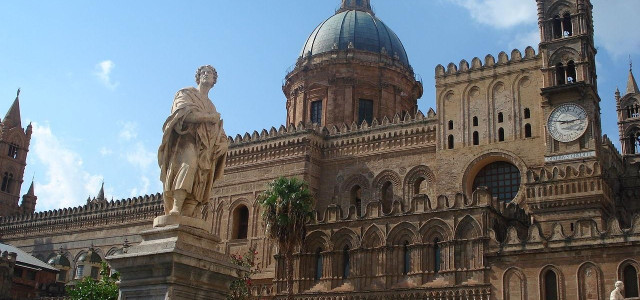Palermo
Palermo (Italian: [paˈlɛrmo] ( ), Sicilian: Palermu, Latin: Panormus, from Greek: Πάνορμος, Panormos, Arabic: بَلَرْم, Balarm; Phoenician: זִיז, Ziz) is a city in Insular Italy, the capital of both the autonomous region of Sicily and the Province of Palermo. The city is noted for its history, culture, architecture and gastronomy, playing an important role throughout much of its existence; it is over 2,700 years old. Palermo is located in the northwest of the island of Sicily, right by the Gulf of Palermo in the Tyrrhenian Sea. The city was founded in 734 BC by the Phoenicians as Ziz ('flower'). Palermo then became a possession of Carthage, before becoming part of the Roman Republic, the Roman Empire and eventually part of the Byzantine Empire, for over a thousand years. The Greeks named the city Panormus meaning 'complete port'. From 831 to 1072 it was under Arab rule during the Emirate of Sicily when it first became a capital. The Arabs corrupted the Greek name into Balarm, the root for its present-day name. Following the Norman reconquest, Palermo became capital of a new kingdom (from 1130 to 1816), the Kingdom of Sicily. Eventually it would be united with the Kingdom of Naples to form the Two Sicilies until the Italian unification of 1860. The population of Palermo urban area is estimated by Eurostat to be 855,285, while its metropolitan area is the fifth most populated in Italy with around 1.2 million people. In the central area, the city has a population of around 650,000 people. The inhabitants are known as Palermitans or, poetically, panormiti. The languages spoken by its inhabitants are the Italian language and the Sicilian language, in its Palermitan variation. Palermo is Sicily's cultural, economic and touristic capital. It is a city rich in history, culture, art, music and food. Numerous tourists are attracted to the city for its good Mediterranean weather, its renowned gastronomy and restaurants, its Romanesque, Gothic and Baroque churches, palaces and buildings, and its nightlife and music. Palermo is the main Sicilian industrial and commercial center: the main industrial sectors include tourism, services, commerce and agriculture. Palermo currently has an international airport, and a significant underground economy. In fact, for cultural, artistic and economic reasons, Palermo was one of the largest cities in the Mediterranean and is now among the top tourist destinations in both Italy and Europe. The city is also going through careful redevelopment, preparing to become one of the major cities of the Euro-Mediterranean area. Roman Catholicism is highly important in Palermitan culture. The patron saint of the city is Saint Rosalia. Her feast day on July 15 is perhaps the biggest social event in the city. The area attracts significant numbers of tourists each year and is widely known for its colourful fruit, vegetable and fish market at the heart of Palermo, known as the Vucciria. History Ancient era Evidence for human settlement in the area now known as Palermo goes back at least to the Mesolithic period, perhaps around 8000 BC, when a group of cave drawings at nearby Addaura represent a new level in the representation of the human figure. According to Thucydides, the Sicani people arrived from the Iberian Peninsula (perhaps Catalonia). During 734 BC the Phoenicians, a sea trading peoples from the north of ancient Canaan, built a small settlement on the natural harbor of Palermo. Some sources suggest they named the settlement "Ziz." It became one of the three main Phoenician colonies of Sicily, along with Motya and Soluntum. The Greeks, who were the most dominant culture on the island of Sicily due to the powerful city state of Syracuse to the east, instead called the settlement Panormus (Πάνορμος). Its Greek name means "all-port" (παν+ὅρμος) and it was named so because of its fine natural harbour. Palermo was then passed on to the Phoenician's descendants and successors, the Carthaginians. During this period it was a centre of commerce; however a power struggle between the Greeks and the Carthaginians broke out in the form of the Sicilian Wars, causing unrest. It was from Palermo that Hamilcar's fleet (which was defeated at the Battle of Himera) was launched. Palermo for a short time became a Greek possession when Pyrrhus of Epirus gained it during the Pyrrhic War period in 276 BC., but was quickly retaken by Carthage. However, as the Romans flooded into Sicily during the First Punic War, the city came under Roman rule during the First Punic War, only three decades later. The period of Roman rule was quite a calm time for Palermo, which grew into an important Roman trade centre. Middle Ages As the Roman Empire was falling apart, Palermo fell under the control of several Germanic tribes. The first were the Vandals in 440 AD under the rule of their king Geiseric. The Vandals had occupied all the Roman provinces in North Africa by 455 establishing themselves as a significant force. They acquired Corsica, Sardinia and Sicily shortly afterwards. However, they soon lost these newly acquired possessions to the Ostrogoths. The Ostrogothic conquest under Theodoric the Great began in 488; although the Goths were Germanic, Theodoric supported Roman culture and government instead. The Gothic War took place between the Ostrogoths and the Eastern Roman Empire, also known as the Byzantine Empire. Sicily was the first part of Italy to be taken under control of General Belisarius who was commissioned by Eastern Emperor Justinian I who solidified his rule in the following years. After the Byzantines were betrayed by Admiral Euphemius, who fled to Tunisia and begged the Aghlabid leader Ziyadat Allah to help him, there was a Muslim conquest of Sicily in 831, which took until 904 against fierce resistance. The Emirate of Sicily was established. The Muslims rule within the whole island lasted for about 120 years. Palermo (Balarm during Arab rule) displaced Syracuse as the prime city of Sicily. It was said to have then begun to compete with Córdoba and Cairo in terms of importance and splendor. For more than one hundred years Palermo was the capital of a flourishing emirate. The Arabs also introduced many agricultural items which remain a mainstay of Sicilian cuisine. After dynastic quarrels however, there was a Christian reconquest in 1072. The family who returned the city to Christianity were called the Hautevilles, including Robert Guiscard and his army, who is regarded as a hero by the natives. It was under Roger II of Sicily that Norman holdings in Sicily and the southern part of the Italian Peninsula were promoted from the County of Sicily into the Kingdom of Sicily. The kingdom was ruled from Palermo as its capital, with the king's court held at Palazzo dei Normanni. Much construction was undertaken during this period, such as the building of the Palermo Cathedral. The Kingdom of Sicily became one of the wealthiest states in Europe, as wealthy as the fellow Norman state, the Kingdom of England. Sicily, in 1194, fell under the control of the Holy Roman Empire. Palermo was the preferred city of the Emperor Frederick II. Muslims of Palermo emigrated and were expelled during Holy Roman rule. After an interval of Angevin rule (1266–1282), Sicily came under control of Aragon and Barcelona dynasty. By 1330, Palermo's population had declined to 51,000. From 1479, it was ruled by the Kingdom of Spain until 1713 and between 1717 and 1718. Palermo was also managed by Savoy between 1713 and 1717 and 1718–1720 as result of the Treaty of Utrecht. And by Austria between 1720 and 1734. Two Sicilies After the Treaty of Utrecht (1713), Sicily was handed over to the Savoia, but by 1734 it was again a Bourbon possession. Charles III chose Palermo for his coronation as King of Sicily. Charles had new houses built for the increased population, while trade and industry grew as well. However, Palermo was now just another provincial city as the royal court resided in Naples. Charles' son Ferdinand, though disliked by the population, took refuge in Palermo after the French Revolution in 1798. His son Alberto died on the way to Palermo and is buried in the city. From 1820 to 1848 all Sicily was shaken by upheavals, which culminated on January 12, 1848, with a popular insurrection, the first one in Europe that year, led by Giuseppe La Masa. A parliament and constitution were proclaimed. The first president was Ruggero Settimo. The Bourbons soon reconquered Palermo (May 1849), which remained under their rule until the appearance of Giuseppe Garibaldi. This famous general entered Palermo with his troops (the “Thousands”) on May 27, 1860. After the plebiscite later that year Palermo and the whole of Sicily became part of the new Kingdom of Italy (1861). Italian unification and today From that year onwards, Palermo followed the history of Italy as the administrative centre of Sicily. A new cultural, economic and industrial growth was spurred by more families, like the Florio, the Ducrot, the Rutelli, the Sandron, the Whitaker, the Utveggio, and others. In the early twentieth century Palermo expanded outside the old city walls, mostly to the north along the new boulevards, the Via Roma, Via Dante, Via Notarbartolo, and Viale della Libertà. This roads would soon boast a huge number of villas in the Art Nouveau style or Stile Liberty as it is known in Italy. Many of these were designed by the famous architect Ernesto Basile. The Grand Hotel Villa Igiea, designed by Ernesto Basile for the Florio family, is a good example of Palermitan Liberty Style. The very large Teatro Massimo was designed in the same period by Giovan Battista Filippo Basile, and built by the Rutelli & Machì building firm of the industrial and old Rutelli Italian family in Palermo, and was opened in 1897. During World War II, Palermo was untouched until the Allies began to advance up Italy after the Allied invasion of Sicily in 1943. In July, the harbour and the surrounding quarters were heavily bombed by the allied forces and were all but destroyed. Six decades later the city centre has still not been fully rebuilt, and hollow walls and devastated buildings can still be found. In 1946 the city was declared the seat of the Regional Parliament, as capital of a Special Status Region (1947) whose seat is in the Palazzo dei Normanni. Palermo's future seemed to look bright again. Many opportunities were lost in the coming decades, owing to incompetence, incapacity, corruption and abuse of power. The main topic of the modern age is the struggle against the Mafia and bandits like Salvatore Giuliano, who controlled the neighbouring area of Montelepre. The Italian State had to share effective control of the territory, economic as well as administrative, with the Mafia families. The so-called "Sack of Palermo" is one of the major visible faces of this problem. The term is used today to indicate the heavy building speculations that filled the city with poor buildings. The reduced importance of agriculture in the Sicilian economy had led to a massive migration to the cities, especially Palermo, which swelled in size. Instead of rebuilding the city centre the town was thrown into a frantic expansion towards the north, where practically a new town was built. The regulatory plan for the expansion was largely ignored. New parts of town appeared almost out of nowhere, but without parks, schools, public buildings, proper roads and the other amenities that characterise a modern city. The Mafia played a huge role in this process, which was an important element in the Mafia's transition from a mostly rural phenomenon into a modern criminal organisation. The Mafia took advantage of corrupt city officials (a former mayor of Palermo, Vito Ciancimino, has been condemned for his bribery with Mafiosi) and protection coming from the Italian central government itself. Many civil servants lost their lives in the struggle against the criminal organisations of Palermo and Sicily. These include the Carabinieri general Carlo Alberto Dalla Chiesa, the region’s president Piersanti Mattarella, Padre Pino Puglisi, a priest who had fought for the young people living in the suburbs, and courageous magistrates such as Giovanni Falcone and Paolo Borsellino. Palermo is connected to the mainland by an international airport and an increasing number of maritime links. However, land connections remain poor. This and other reasons have until now thwarted the development of tourism. This has been identified as the main resource to exploit for the city's recovery, the legacy of three millennia of history and folklore. Geography Administration Shown above are the thirty five quarters of Palermo: these thirty five neighbourhoods or "quartiere" as they are known, are further divided into eight governmental community boards. Climate Palermo experiences a hot-summer Mediterranean climate (Köppen climate classification: Csa). Winters are mild and wet, while Summers are hot and dry. Palermo is one of the warmest cities in Europe (mainly due to its warm nights), with an average annual ambient air temperature of 18.5 °C (65.3 °F). It receives approximately 2,530 hours of sunshine per year. Snow is rare but not impossible. In the late 40's and in the early 2000s it snowed as far as the harbour eight times. More often snow stopped on the edge of the city. The average annual temperature of the sea is above 19 °C (66 °F), from 14 °C (57 °F) in February to 26 °C (79 °F) in August. In the period from May to November, the average sea temperature exceeds 18 °C (64 °F) and in the period from June to October, the average sea temperature exceeds 21 °C (70 °F). Landmarks Palermo has a large architectural heritage and is notable for its many Norman buildings. Churches Palermo Cathedral: Located at Corso Vittorio Emanuele, corner Via Matteo Bonello, its long history has led to the accumulation of different architectural styles, the last, was in the 18th century. San Giovanni dei Lebbrosi San Giovanni degli Eremiti (St. John of the Hermit Order): Located near the Palazzo dei Normanni, this 12th-century church is notable for its bright red domes, a residue of Arab influences in Sicily. In his Diary of an Idle Woman in Sicily, F. Elliot described it as "... totally oriental... it would fit well in Baghdad or Damascus". The bell tower, with four orders of arcaded loggias, is instead an example of Gothic architecture. Chiesa della Martorana: Also known as Santa Maria dell'Ammiraglio (St Mary of the Admiral), the church is annexed to the next-door church of San Cataldo and overlooks Piazza Bellini in central Palermo. The original layout was a compact cross-in-square ("Greek cross plan"), a common south Italian and Sicilian variant of the middle Byzantine period church format. The three eastern apses adjoin directly the naos, instead of being separated by an additional bay, as was usual in contemporary Byzantine architecture in of the East. The campanile, richly decorated with three orders of arches and lodges with mullioned windows, still serves as the main entrance to the church. The interior decoration is elaborate, and includes Byzantine mosaics. San Cataldo: This church, on the central Piazza Bellini next to the Martorana, exemplifies Norman architecture. Santa Maria della Gancia Santa Maria della Catena: This church, was built in 1490–1520 using designs by Matteo Carnilivari; the name derives from the chains (Italian: catena) once attached to one of the walls, which were used to close the port. San Giuseppe dei Teatini: Located near the Quattro Canti, it is an example of Sicilian Baroque. Oratorio di San Lorenzo Oratorio del Rosario Santa Teresa alla Kalsa derives its name from Al-Khalisa, an Arab term meaning elected. The church, constructed in 1686–1706 over the former emir's residence, is one of the most outstanding examples of Sicilian Baroque. It has a single, airy nave, with stucco decorations from the early 18th century. Santa Maria dello Spasimo was built in 1506 and later turned into a hospital. For this church Raphael painted his famous Sicilia's Spasimo, now in the Museo del Prado. The church today is a fascinating open-air auditorium, which occasionally houses exhibitions and musical shows. Church of the Gesu, Palermo (Church of the Jesus): Located in the city center, in 1564 the church was built in late-Renaissance style by the Jesuits. It was built over a pre-existing convent of Basilian monks. Alterations in 1591 were completed in a Sicilian Baroque. The church was heavily damaged after the 1943 bombings, which destroyed most of the frescoes. The interior has a Latin cross plan with a nave and two aisles, and has a particularly rich decoration of marbles, tarsias and stuccoes, especially in the St Anne's Chapel. At the right is the Casa Professa, with a 1685 portal and a precious 18th century cloister. The Church is now home to the Municipal Library, placed here in 1775. San Francesco di Assisi: this church was built between 1255 and 1277 in what was once the market district of the city, at the site of two pre-existing churches and was largely renovated in the 15th, 16th, 18th and 19th centuries, the latter after an earthquake. After the 1943 bombings, the church was restored to its Medieval appearance, which now includes part of the original building such as part of the right side, the apses and the Gothic portal in the façade. The interior has a typical Gothic flavor, with a nave and two aisles separated by two rows of cylindrical pilasters. Some of the chapels are in Renaissance style, as well as the late 16th century side portals. The church includes precious sculptures by Antonio and Giacomo Gagini and Francesco Laurana, plus a noteworthy wooden choir dating from the 16th century. Of note are also the allegorical statues by Giacomo Serpotta (1723), also author of the stucco decoration. Church of the Magione: Officially known as the church of the Holy Trinity), This church was built in Norman style in 1191 by Matteo d'Ajello, who donated it to the Cistercian monks. Palaces and museums Palazzo dei Normanni, one of the most beautiful Italian palaces and a notable example of Norman architecture, probably built over an Arab fortress. It houses the famous Cappella Palatina. Zisa (1160) and Cuba, magnificent castles/houses used by the kings of Palermo for hunting. Similar buildings were common in northern Africa, but today these two are the only ones remaining. The Zisa houses the Islamic museum. The Cuba was once encircled by water. Palazzo Chiaramonte Palazzo Abatellis, with the Regional Gallery. It was built at the end of the 15th century for the prefect of the city, Francesco Abatellis. It is a massive though elegant construction, in typical Catalan Gothic style, with Renaissance influences. The Gallery houses an Eleonora of Aragon bust by Francesco Laurana (1471) and the Malvagna Triptych (c. 1510), by Jan Gossaert and the famous Annunziata by Antonello da Messina. The exposition in the museum has been designed by the architect Carlo Scarpa. The Regional Archeological Museum Antonio Salinas is one of the main museums of Italy: it includes numerous remains from Etruscan, Carthaginian, Roman and Hellenistic civilizations. It houses all the decorative parts from the Sicilian temples of Segesta and Selinunte. City Walls Palermo has at least 2 circuits of City Walls - many pieces of which still survive. The first circuit surrounded the ancient core of the punic City - the so-called Palaeopolis (in the area east of Porta Nuova) and the Neopolis. Via Vittorio Emanuele was the main road E-W through this early walled City. The eastern edge of the walled City was on Via Roma and the ancient port in the vicinity of Piazza Marina. The wall circuit was approximately Porto Nuovo, Corso Alberti, Piazza Peranni, Via Isodoro, Via Candela, Via Venezia, Via Roma, Piazza Paninni, Via Biscottari, Via Del Bastione, Palazzo dei Normanni and back to Porto Nuovo. In the medieval period the wall circuit was expanded. Via Vittorio Emanuele continued to be the main road E-W through the walled City. West gate was still Porta Nuova, the circuit continued to Corso Alberti, to Piazza Vittorio Emanuele Orlando where it turned east along Via Volturno to Piazza Verdi and along the line of Via Cavour. At this North East corner there was a defense, Castello a Mare, to protect the port at La Cala. A huge chain was used to block La Cala with the other end at S Maria della Catena (St Mary of the Chain). The sea-side wall was along the western side of Foro Italico Umberto. The wall turns west along the northern side of Via Abramo Lincoln, continues along Corso Tukory. The wall turns north approximately on Via Benedetto, to Palazzo dei Normanni and back to Porta Nuova. Source: Palermo - City Guide by Adriana Chirco, 1998, Dario Flaccovio Editore. Several gates in the City Wall survive. Images of the City Wall can be see here Opera houses The Teatro Massimo ("Greatest Theatre") was opened in 1897. It is the biggest in Italy (8000 m2), and one of the largest of Europe (the third after the Opéra National de Paris and the K. K. Hof-Opernhaus in Vienna), renowned for its perfect acoustics. Closed for renovation from 1974 until 1997, it is now carefully restored and has an active schedule. Enrico Caruso sang in a performance of La Gioconda during the opening season, returning for Rigoletto at the very end of his career. The Teatro Politeama was built between 1867 and 1874 Squares Quattro Canti is a small square at the crossing of the ancient main roads (now: Corso Vittorio Emanuele and Via Maqueda) dividing the town into its quarters (mandamenti). The buildings at the corner have diagonal baroque façades so that the square gets an almost octagonal form. Piazza Pretoria was planned in the 16th century near the Quattro Canti as the site of a fountain by Francesco Camilliani, the Fontana Pretoria Other sights The cathedral has a heliometer (solar "observatory") of 1690, one of a number built in Italy in the 17th and 18th centuries. The device itself is quite simple: a tiny hole in one of the minor domes acts as Pinhole camera, projecting an image of the sun onto the floor at solar noon (12:00 in winter, 13:00 in summer). There is a bronze line, la Meridiana on the floor, running precisely N/S. The ends of the line mark the positions as at the summer and winter solstices; signs of the zodiac show the various other dates throughout the year. The purpose of the instrument was to standardise the measurement of time and the calendar. The convention in Sicily had been that the (24 hour) day was measured from the moment of sun-rise, which of course meant that no two locations had the same time and, more importantly, did not have the same time as in St. Peter's Basilica in Rome. It was also important to know when the Vernal Equinox occurred, to provide the correct date for Easter. The Orto botanico di Palermo, founded in 1785, is the largest in Italy with a surface of 10 ha. One site of interest is the Capuchin Catacombs, with many mummified corpses in varying degrees of preservation. Close to the city is the 600 m-high Monte Pellegrino, offering a panorama of the city, its surrounding mountains and the sea. Demographics In 2010, there were 1.2 million people living in the greater Palermo area, 655,875 of which resided in the City of Palermo, and of whom 47.4% were male and 52.6% were female. People under age 15 totalled 15.6% of the population compared to pensioners who number 17.2. This compares with the Italian average of 14.1% (people under age 15) and 20.2% pensioners. The average age of Palermo resident is 40.4 compared to the Italian average of 42.8. In the ten years between 2001 and 2010, the population of Palermo declined by 4.5%, while the population of Italy, as a whole, grew by 6.0%. The reason for Palermo's decline is a population flight to the suburbs, and to Northern Italy. The current birth rate of Palermo is 10.2 births per 1,000 inhabitants compared to the Italian average of 9.3 births. As of 2006, 97.79% of the population was of Sicilian/Italian descent. The largest immigrant group came from South Asia (mostly from Sri Lanka): 0.80%, other European countries (mostly from Albania, Romania, Serbia, Macedonia and Ukraine, ): 0.3%, and North Africa (mostly from Tunisia): 0.28%. Economy Being Sicily's administrative capital, Palermo is home to much of the region's main economic, financial, touristic and commercial life. The city currently hosts an international airport, and Palermo's economic growth over the years has brought to the opening of many new businesses and entrepreneurial opportunities. The economy mainly relies on tourism and services, but also commerce, shipbuilding, trade and agriculture. The city, however, still has high unemployment levels, high corruption and a significant black market empire (Palermo being the home of the Sicilian Mafia). Even though the city still suffers from widespread corruption, inefficient bureaucracy and organized crime (Mafia), Palermo's crime level has gone down dramatically, unemployment has been decreasing and many new, profitable, strategies (especially regarding tourism) have been introduced, making the city safer and better to live in. Education The local university is the University of Palermo, the island's second oldest university. It was officially founded in 1806, although historical records indicate that medicine and law have been taught there since the late 15th century. The Orto botanico di Palermo (Palermo botanical gardens) is home to the university's Department of Botany and is also open to visitors. Sports Palermo has a professional football team, U.S. Città di Palermo, who compete in Serie A. The chairman is Maurizio Zamparini and the coach is Giuseppe Iachini. The Targa Florio was an open road endurance car race held near Palermo. Founded in 1906, it used to be one of the oldest sports car racing events until it was discontinued in 1977 due to safety concerns but has since run as a rallying event. Palermo was home to the grand depart of the 2008 Giro d'Italia. The initial stage was a 28.5 km (17.7 mi) long TTT (Team Time Trial) held on May 10. Internazionali Femminili di Palermo is a WTA Tour Tier IV tournament in Palermo. Infrastructure Public transportation Palermo has commuter rail called Palermo metropolitan railway service. Palermo's public bus system is operated by AMAT and it develops a net of 340 km (211 mi) divided by about 90 lines reaching every zone of the town. The AST, with its coaches divided in 35 lines, links Palermo to all the cities of provincia di Palermo and the main in Sicily. Roads Palermo is a key node for the sicilian road network, being the junction between east A19 highway to Trapani, the south-east A29 to airport and Mazzara del Vallo and the south-west A19 to Messina and A20 to Catania. Palermo is one of the main city on the european route E90. Other national roads link Palermo to every place in Sicily. Airports Palermo International Airport, also known as Falcone-Borsellino Airport or Punta Raisi Airport, is dedicated to Giovanni Falcone and Paolo Borsellino, two anti-mafia judges killed by the mafia in the early 1990s, is located 32 km (20 mi) west of Palermo (Punta Raisi). The airport's rail facility, known as Punta Raisi railway station, can be reached by trains departing from Palermo Centrale, Palermo Notarbartolo and Palermo Francia. Palermo-Boccadifalco Airport is the second airport of the city. Port The port of Palermo, founded by Phoenicia over 2700 years ago, is the main gate to reach Sicily together with port of Messina. From here the ferries link Palermo to Cagliari, Genoa, Livorno, Naples, Tunis and others for a total of almost 2 millions passengers yearly. It's an important port for the cruise ships. Traffic include also almost 5 mllions tonnes of cargo and 80.000 TEU yearly. The port has also links to the minor sicilian islands like Ustica and the Aeolian Islands (in summer via Cefalù). National rail The main station of Palermo is Palermo Centrale and links through the Ferrovie dello Stato net to the other cities of Sicily, including Agrigento, Trapani and Catania, and through Messina and the strait to the rest of Italy. The railways also connect to the Palermo airport with departures every thirty minutes. Patron saints The patron saint of Palermo is Santa Rosalia, who is widely venerated. On 14 July, people in Palermo celebrate the Festino, the most important religious event of the year. The Festino is a procession in the main street of Palermo to remember the miracle attributed to Santa Rosalia who, it is believed by the vast majority of people, freed the city from the Black Death in 1624. The cave where the bones of Santa Rosalia were discovered is on Monte Pellegrino (see above): when her relics were carried around the city three times, the plague was lifted. There is a Santuario marking the spot and can be reached via a scenic bus ride from the city below. Before 1624 Palermo had four patron saints, one for each of the four major parts of the city. They were Saint Agatha, Saint Christina, Saint Ninfa and Saint Olivia. Saint Lucy is also honoured with a peculiar celebration, during which inhabitants of Palermo do not eat anything made with flour, but boil wheat in its natural state and use it to prepare a special dish called cuccìa. This commemorates the saving of the city from famine through the intercession of St Lucia. A ship full of grain mysteriously arrived in the city's harbour and the population was so hungry that they did not waste time in making flour but ate the grain as it had arrived. Saint Benedict the Moor is the heavenly protector of the city of Palermo. The ancient patron of the city was the Genius of Palermo, genius loci and numen protector of the place, that became the laic patron of the modern Palermo. International relations Twin towns and sister cities Palermo is twinned with: Photo gallery See also List of mayors of Palermo Hugo Falcandus References Sources Fabbri, Patrizia (2005). Palermo e Monreale. Florence: Bonechi. Almsaodi, Aymn. The Desert Race. Appleton, D (2005). The World in the Middle Ages. University of Michigan. External links Official website (Italian) Palermo Tourist Board Palermo Coupon
